LUBBOCK — Each winter, after the ocean of cotton has been harvested within the South Plains and the bottom appears barren, technicians with the Excessive Plains Underground Water Conservation District examine the water ranges in almost 75,000 wells throughout 16 counties.
For years, their measurements have proven what farmers and water conservationists worry most—the Ogallala Aquifer, an underground water supply that’s the lifeblood of the South Plains agriculture business, is working dry.
That’s due to a century-old legislation referred to as the rule of seize.
The rule is straightforward: For those who personal the land above an aquifer in Texas, the water beneath is yours. You should use as a lot as you need, so long as it’s not wasted or taken maliciously. The identical applies to your neighbor. In the event that they occur to make use of extra water than you, then that’s simply unhealthy luck.
To place it one other manner, landowners can principally pump as a lot water as they select with out dealing with legal responsibility to surrounding landowners whose wells is perhaps depleted consequently.
Following the Mud Bowl—and to stave off disaster—state lawmakers created groundwater conservation districts in 1949 to guard what water is left. However their energy to limit landowners is restricted.
“The mission is to avoid wasting as a lot water doable for so long as doable, with as little affect on personal property rights as doable,” mentioned Jason Coleman, supervisor for the Excessive Plains Underground Water Conservation District. “How do you try this? It’s a tough process.”
Speedy inhabitants development, local weather change, and growing old water infrastructure all threaten the state’s water provide. Texas does not have enough water to meet demand if the state is stricken with a historic drought, based on the Texas Water Growth Board, the state company that manages Texas’ water provide.
Lawmakers wish to put money into each nook to avoid wasting the state’s water. This week, they reached a historic $20 billion deal on water tasks.
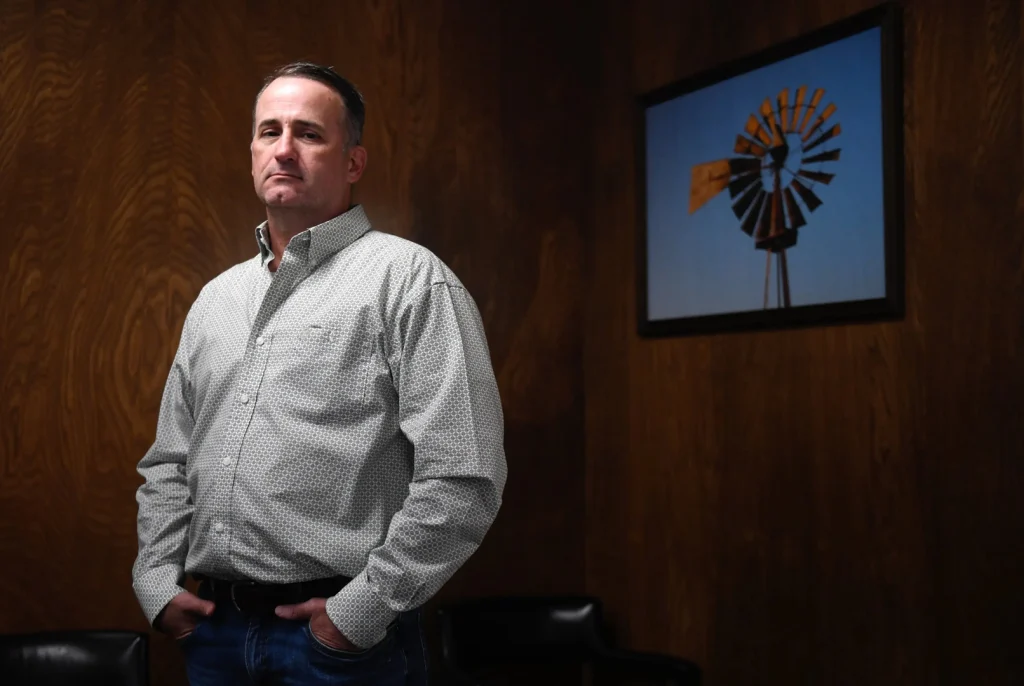
However nobody desires to the touch the rule of seize. In a state recognized for rugged individualism, politically talking, reforming the legislation is tantamount to stripping away freedoms.
“There in all probability are alternatives to vest groundwater districts with extra authority,” mentioned Amy Hardberger, director for the Texas Tech College Middle for Water Legislation and Coverage. “I don’t assume the political local weather goes to try this.”
State Sen. Charles Perry, a Lubbock Republican, and Rep. Cody Harris, a Palestine Republican, led the trouble on water in Austin this yr. Neither responded to requests for remark.
Carlos Rubinstein, a water skilled with consulting agency RSAH2O and a former chairman of the water growth board, mentioned the rule has been relied upon so lengthy that it will be close to inconceivable to undo the legislation.
“I believe it’s higher to spend time working inside the guidelines,” Rubinstein mentioned. “And respect the rule of seize, but additionally acknowledge that, in and of itself, it causes issues.”
Despite the fact that groundwater districts had been created to control groundwater, the legislation successfully stops them from doing so, or they threat main lawsuits. The state water plan, which spells out how the state’s water is for use, acknowledges the shortfall. Groundwater availability is expected to decline by 25% by 2070, principally attributable to lowered provide within the Ogallala and Edwards-Trinity aquifers. Collectively, the aquifers stretch throughout West Texas and up by means of the Panhandle.
By itself, the Ogallala has an estimated three trillion gallons of water. Although the overwhelming majority in Texas is utilized by farmers. It’s anticipated to face a 50% decline by 2070.
Groundwater is 54% of the state’s whole water provide and is the state’s most susceptible pure useful resource. It’s created by rainfall and different precipitation, and seeps into the bottom. Like floor water, groundwater is closely affected by ongoing droughts and extended warmth waves. Nevertheless, the state has extra say in regulating floor water than it does groundwater. Floor water legal guidelines have provisions that cut supply to newer users in a drought and prohibit transferring floor water outdoors of basins.
Traditionally, groundwater has been utilized by agriculture within the Excessive Plains. Nevertheless, as floor water evaporates at a faster clip, cities and companies are more and more fascinated by tapping the underground useful resource. As Texas’ inhabitants continues to develop and floor water declines, groundwater would be the prize in future fights for water.
In some ways, the harm is completed within the Excessive Plains, a area that spans from the highest of the Panhandle down previous Lubbock. The Ogallala Aquifer runs beneath the area, and it’s confronted depletion to the purpose of no return, based on specialists. Merely put: The Ogallala will not be refilling to maintain up with demand.
“It’s a creeping catastrophe,” mentioned Robert Mace, govt director of the Meadows Middle for Water and the Atmosphere. “It isn’t such as you get up tomorrow and no person can pump anymore. It’s simply occurring slowly, yearly.”
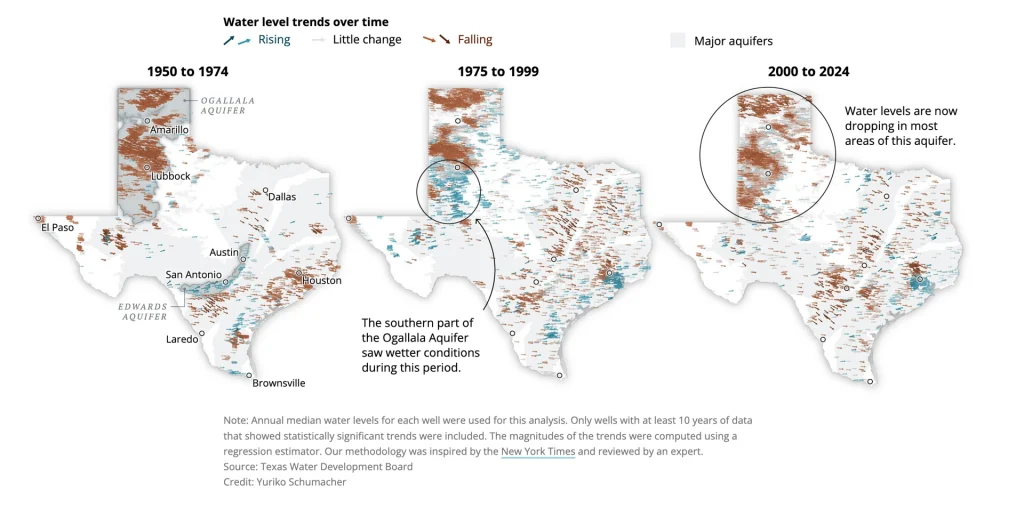
Groundwater districts and the legislation
The Excessive Plains Water District was the primary groundwater district created in Texas.
Over a protracted multi-year combat, the Legislature created these new native authorities our bodies in 1949, with voter approval, enshrining the brand new stewards of groundwater into the state Structure.
If the lawmakers hoped to embolden native officers to handle the troves of water below the soil, they failed. There are areas with groundwater that don’t have conservation districts. Every groundwater districts has totally different powers. In follow, most water districts allow wells and make selections on spacing and site to satisfy the wants of the property proprietor.
The one factor all groundwater districts have in widespread: They cease in need of telling landowners they will’t pump water.
Within the seven a long time since groundwater districts had been created, a series of lawsuits have successfully strangled groundwater districts. Whilst water ranges decline from use and drought, districts nonetheless get common requests for brand new wells. They gained’t say no out of worry of litigation.
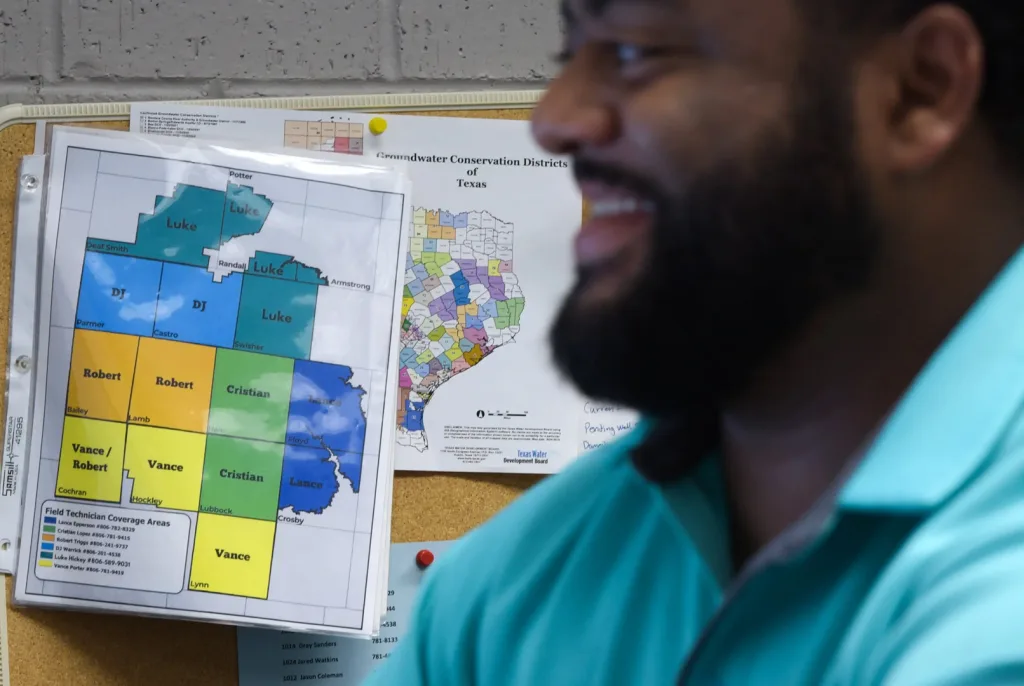
“You’ve got a number of various selections to make because it pertains to administration of groundwater,” Coleman mentioned. “That checklist has grown over time.”
The potential of lawsuits makes groundwater districts hesitant to control utilization or put limitations on new effectively permits. Groundwater districts must defend themselves in lawsuits, and most lack the sources to take action.

“The legislation works towards us in that manner,” Hardberger, with Texas Tech College, mentioned. “It means one massive instrument in our toolbox, regulation, is restricted.”
The newest instance is a lawsuit between the Braggs Farm and the Edwards Aquifer Authority. The farm requested permits for 2 pecan orchards in Medina County, outdoors San Antonio. The authority granted just one and restricted how a lot water might be used based mostly on state legislation.
It wasn’t an arbitrary determination. The authority mentioned it adopted the statute set by the Legislature to find out the allow.
“That’s all they had been assured,” mentioned Gregory Ellis, the primary normal supervisor of the authority, referring to the water obtainable to the farm.
The Braggs household filed a takings lawsuit towards the authority. This sort of declare may be filed when any stage of presidency—together with groundwater districts—takes personal property for public use with out paying for the proprietor’s losses.
Braggs won. It’s the solely profitable water-related takings declare in Texas, and it made groundwater legal guidelines murkier. It value the authority $4.5 million.
“I believe it ought to have been paid by the state Legislature,” Ellis mentioned. “They’re those who designed that allowing system. However that didn’t occur.”
An appeals court docket upheld the ruling in 2013, and the Texas Supreme Court docket denied petitions to think about appeals. Nevertheless, the state’s supreme court docket has beforehand steered the Legislature may improve the powers of the groundwater districts and regulate groundwater like floor water, simply as many different states have accomplished.
Whereas the legal guidelines are sophisticated, Ellis mentioned the elemental rule of seize has advantages. It has saved Texas’ authorized system from a flurry of lawsuits between effectively homeowners.
“If that they had mentioned ‘Sure, you’ll be able to sue your neighbor for damaging your effectively,’ the place does it cease?” Ellis requested. “All people sues everyone.”
Coleman, the Excessive Plains district’s supervisor, mentioned some folks need groundwater districts to have extra energy, whereas others assume they’ve an excessive amount of. Nicely homeowners need restrictions for others, however not on them, he mentioned.
“You’re charged as a district with attempting to use issues uniformly and pretty,” Coleman mentioned.
Can’t reverse the previous
Two tractors had been dropping seeds round Walt Hagood’s farm as he turned on his irrigation system for the primary time this yr. He didn’t plan on utilizing a lot water. It’s too treasured.
The cotton farm stretches throughout 2,350 acres on the outskirts of Wolfforth, a city 12 miles southwest of Lubbock. Hagood irrigates about 80 acres of land, and prays that rain takes care of the remaining.
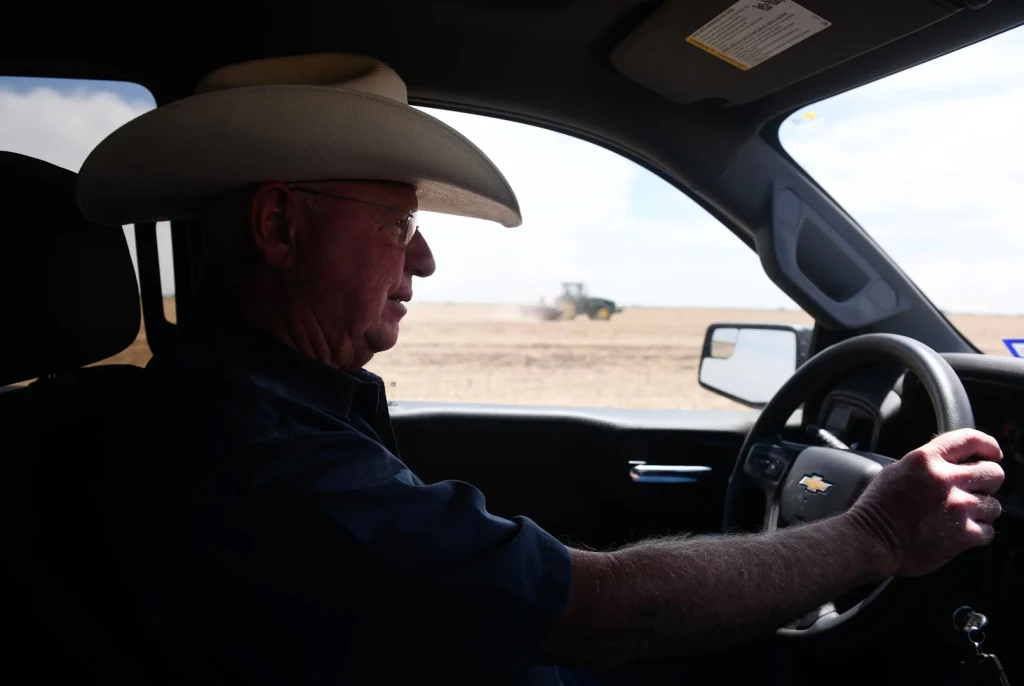
“We used to have lots of irrigated land with satisfactory water to make a crop,” Hagood mentioned. “We don’t have that anymore.”
The Excessive Plains is dwelling to cotton and cattle, multi-billion-dollar agricultural industries. The success is largely as a result of Ogallala. Since its discovery, the aquifer has helped farms across the area spring up by means of irrigation, a manner for farmers to water their crops as an alternative of ready for rain that won’t come. However as water within the aquifer declines, there are rising considerations that there gained’t be sufficient water to help agriculture sooner or later.
On the peak of irrigation growth, greater than 8.5 million acres had been irrigated in Texas. About 65% of that was within the Excessive Plains. Within the a long time because the irrigation increase, Excessive Plains farmers have resorted to strategies that may save water and maintain their livelihoods afloat. They’ve modified their irrigation programs so water is used extra effectively. They develop cowl crops so their soil is extra seemingly to take in rainwater. Some use apps to see the place water is required so it’s not wasted.
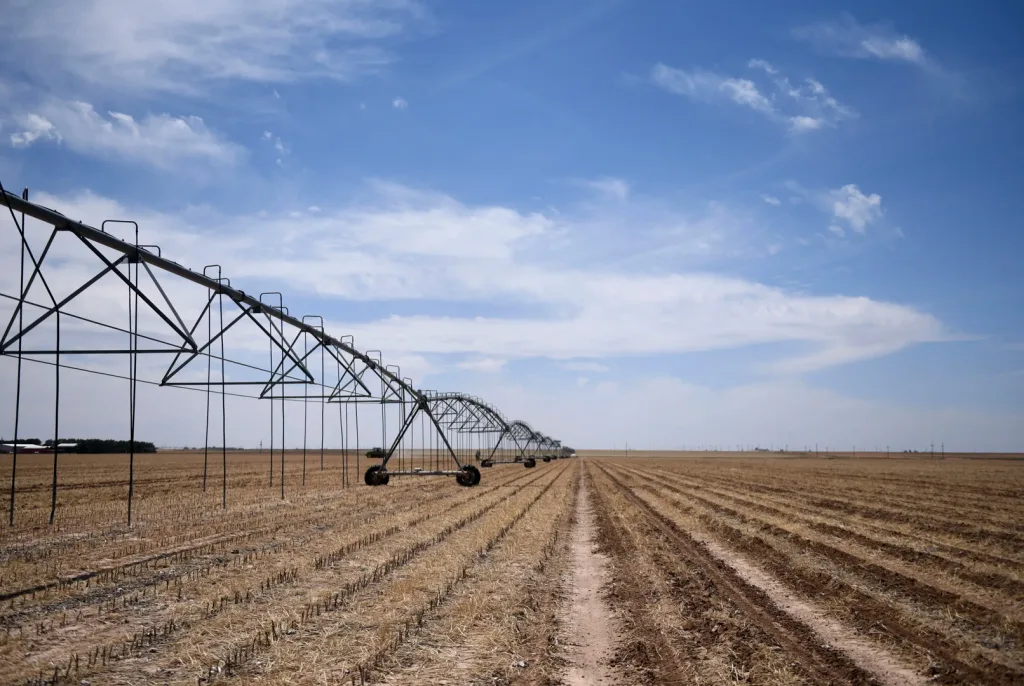
Farmers who haven’t modified their irrigation programs won’t have a selection within the close to future. It could actually take per week to pump an inch of water in some areas from the aquifer due to how little water is left. As circumstances change underground, they’re compelled to drill deeper for water. That causes extra issues. Calcium can construct up, and the water is of poorer high quality. And when the water is used to spray crops by means of a pivot irrigation system, it’s extra of a humidifier as water shortly evaporates within the warmth.
In line with the groundwater district’s most up-to-date administration plan, 2 million acres within the district use groundwater for irrigation. About 95% of water from the Ogallala is used for irrigated agriculture. The plan states that the irrigated farms “afford financial stability to the realm and help various different industries.”
The state water plan exhibits groundwater provide is anticipated to say no, and drought gained’t be the one issue inflicting a scarcity. Demand for municipal use outweighs irrigation use, reflecting the state’s future development. In Area O, which is the South Plains, water for irrigation declines by 2070 whereas demand for municipal use rises due to inhabitants development within the area.
Coleman, with the Excessive Plains groundwater district, typically thinks about how the aquifer will maintain up with future development. There are some elements at play with water planning which can be almost inconceivable to foretell and account for, Coleman mentioned. Declining floor water may make groundwater a supply for municipalities that didn’t rely on it earlier than. Areas recognized for having massive, open patches of land, just like the Excessive Plains, might be engaging to incoming companies. Folks may transfer to the nation and wish to drill a effectively, with no understanding of water availability.
The state will proceed to develop, Coleman mentioned, and all of the incoming companies and industries will undoubtedly want water.
“Let’s imagine ‘Nicely, it’s nobody’s fault. We didn’t know that manufacturing unit would want 20,000 acre-feet of water a yr,” Coleman mentioned. “It’s not occurring proper now, however what’s across the nook?”
Coleman mentioned this places agriculture in a tenuous place. The area is stuffed with small cities that rely on agriculture and have supporting companies, like cotton gins, tools and feed shops, and pesticide and fertilizer sprayers. This places strain on the Excessive Plains water district, together with the 2 regional water planning teams within the area, to maintain agriculture alive.
“Districts should not attempting to scale back pumping all the way down to a sustainable stage,” mentioned Mace with the Meadows Basis. “And I don’t fault them for that, as a result of doing that’s financial devastation in a area with farmers.”
Hagood, the cotton farmer, doesn’t assume reforming groundwater rights is the way in which to resolve it. What’s accomplished is completed, he mentioned.
“Our U.S. Structure protects our personal property rights, and that’s what that is all about,” Hagood mentioned. “Any time we have now a regulation and individuals are given extra authority, it doesn’t work out proper for everyone.”

What may be accomplished
The state water plan recommends irrigation conservation as a method. It’s additionally the least expensive water administration technique.
However that technique is fraught. Farmers have to irrigate in occasions of drought, and telling them to cease can draw criticism.
In Jap New Mexico, the Ogallala Land and Water Conservancy, a nonprofit group, has been retiring irrigation wells. Landowners maintain their water rights, and the group pays them to cease irrigating their farms. Landowners receives a commission yearly as a part of the voluntary settlement, they usually can finish it at any level.
Ladona Clayton, govt director of the group, mentioned they’ve been criticized, with their efforts being referred to as a “battle” and “land seize.” Additionally they get pushback on why the accountability falls on farmers. She mentioned it’s due to how a lot water is used for irrigation. They must be aggressive of their strategy, she mentioned. The aquifer provides water to the Cannon Air Drive Base.
“We don’t need them to cease agricultural manufacturing,” Clayton mentioned. “However for me to say it will likely be the identical stage that irrigation can help could be unfaithful.”
There’s one other doable lifeline that folks within the Excessive Plains are eyeing as an answer: the Dockum Aquifer. It’s a minor aquifer that underlies a part of the Ogallala, so it will be accessible to farmers and ranchers within the area. The Excessive Plains Water District additionally oversees this aquifer.
If it appears too good to be true—that essentially the most irrigated a part of Texas would simply so occur to have one other plentiful provide of water flowing beneath—it’s as a result of there’s a catch. The Dockum is stuffed with extraordinarily salty brackish water. Some counties can use the water for irrigation and consuming water with out therapy, however it’s unusable in others. In line with the groundwater district, a check effectively in Lubbock County pulled up water that was as salty as seawater.
Rubinstein, the previous water growth board chairman, mentioned there are pockets of brackish groundwater in Texas that haven’t been tapped but. It could be sufficient to satisfy the wants on the horizon, however it will even be very costly to acquire and use. A landowner must go deeper to get it, then pump the water over an extended distance.
“That prices cash, after which you must deal with it on high of that,” Rubinstein mentioned. “However, it’s water.”
Landowners have expressed curiosity in utilizing desalination, a treatment method to lower dissolved salt levels. Desalination of produced and brackish water is without doubt one of the concepts that was being floated round on the Legislature this yr, together with constructing a pipeline to maneuver water throughout the state. Hagood, the farmer, is skeptical. He thinks no matter water they transfer may get used up earlier than it makes all of it the way in which to West Texas.
There’s all the time brackish groundwater. One other aquifer brings the possibility of historical past repeating—if the Dockum aquifer is handled so its water is usable, will folks drain it, too?
Hagood mentioned there must be limits.
Disclosure: Edwards Aquifer Authority and Texas Tech College have been monetary supporters of The Texas Tribune. Monetary supporters play no position within the Tribune’s journalism. Discover a full list of them here.
This article initially appeared in The Texas Tribune, a member-supported, nonpartisan newsroom informing and interesting Texans on state politics and coverage. Study extra at texastribune.org.


